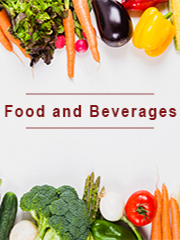Report overview
A colloid, also called a colloidal system, is a chemical system that features very fine particles suspended in a continuous medium. Hydrocolloids, as the name indicates, are colloidal long-chained polymeric systems made of fine particles and dispersed in water. Depending on how much water has been used, hydrocolloids could occur in the form of either gels or sols.
Given their physical attributes, hydrocolloids are used in numerous applications. Their range of application in the food industry is especially wide because they carry the capability to modify the rheology of virtually any system to which they?re added. The other main applications of hydrocolloids are seen in the cosmetics and pharmaceuticals sector.
This report aims to provide a comprehensive presentation of the global market for Food Hydrocolloids, with both quantitative and qualitative analysis, to help readers develop business/growth strategies, assess the market competitive situation, analyze their position in the current marketplace, and make informed business decisions regarding Food Hydrocolloids. This report contains market size and forecasts of Food Hydrocolloids in global, including the following market information:
Global Food Hydrocolloids Market Revenue, 2018-2023, 2024-2029, ($ millions)
Global Food Hydrocolloids Market Sales, 2018-2023, 2024-2029, (K MT)
Global top five Food Hydrocolloids companies in 2022 (%)
The global Food Hydrocolloids market was valued at US$ 5317.6 million in 2022 and is projected to reach US$ 7910.4 million by 2029, at a CAGR of 5.8% during the forecast period. The influence of COVID-19 and the Russia-Ukraine War were considered while estimating market sizes.
Global Food Hydrocolloids key players include Kraft Foods Group Inc., JM Huber Corp(CP Kelco), Fufeng, Ingredion, etc. Global top four manufacturers hold a share nearly 25%.
Europe is the largest market, with a share over 30%, followed by China, and North America, both have a share about 40 percent.
In terms of product, Guar gum is the largest segment, with a share over 30%. And in terms of application, the largest application is Jelly or Pudding, followed by Processed meat, Beverage, Dressing or sauce, etc.
We surveyed the Food Hydrocolloids manufacturers, suppliers, distributors and industry experts on this industry, involving the sales, revenue, demand, price change, product type, recent development and plan, industry trends, drivers, challenges, obstacles, and potential risks.
Total Market by Segment:
Global Food Hydrocolloids Market, by Type, 2018-2023, 2024-2029 ($ Millions) & (K MT)
Global Food Hydrocolloids Market Segment Percentages, by Type, 2022 (%)
Agar
Alginates
Carboxymethylcellulose and Other Cellulose Ethers
Carrageenan
Gelatin
Gellan Gum
Guar Gum
Gum Acacia (Gum Arabic)
Locust Bean Gum
Others
Global Food Hydrocolloids Market, by Application, 2018-2023, 2024-2029 ($ Millions) & (K MT)
Global Food Hydrocolloids Market Segment Percentages, by Application, 2022 (%)
Beverage
Dressing or Sauce
Jelly or Pudding
Dairy Products
Ice Cream
Soup
Processed Meat
Others
Global Food Hydrocolloids Market, By Region and Country, 2018-2023, 2024-2029 ($ Millions) & (K MT)
Global Food Hydrocolloids Market Segment Percentages, By Region and Country, 2022 (%)
North America
US
Canada
Mexico
Europe
Germany
France
U.K.
Italy
Russia
Nordic Countries
Benelux
Rest of Europe
Asia
China
Japan
South Korea
Southeast Asia
India
Rest of Asia
South America
Brazil
Argentina
Rest of South America
Middle East & Africa
Turkey
Israel
Saudi Arabia
UAE
Rest of Middle East & Africa
Competitor Analysis
The report also provides analysis of leading market participants including:
Key companies Food Hydrocolloids revenues in global market, 2018-2023 (Estimated), ($ millions)
Key companies Food Hydrocolloids revenues share in global market, 2022 (%)
Key companies Food Hydrocolloids sales in global market, 2018-2023 (Estimated), (K MT)
Key companies Food Hydrocolloids sales share in global market, 2022 (%)
Further, the report presents profiles of competitors in the market, key players include:
JM Huber Corp(CP Kelco)
Ingredion
DuPont
Cargill
Kerry Group
Ashland
Hindustan Gum & Chemicals Ltd
Kraft Foods Group Inc.
DSM
Jai Bharat Gum & Chemicals Ltd
Fufeng
Meihua
Caremoli Group
Behn Meyer
Iberagar
Outline of Major Chapters:
Chapter 1: Introduces the definition of Food Hydrocolloids, market overview.
Chapter 2: Global Food Hydrocolloids market size in revenue and volume.
Chapter 3: Detailed analysis of Food Hydrocolloids manufacturers competitive landscape, price, sales and revenue market share, latest development plan, merger, and acquisition information, etc.
Chapter 4: Provides the analysis of various market segments by type, covering the market size and development potential of each market segment, to help readers find the blue ocean market in different market segments.
Chapter 5: Provides the analysis of various market segments by application, covering the market size and development potential of each market segment, to help readers find the blue ocean market in different downstream markets.
Chapter 6: Sales of Food Hydrocolloids in regional level and country level. It provides a quantitative analysis of the market size and development potential of each region and its main countries and introduces the market development, future development prospects, market space of each country in the world.
Chapter 7: Provides profiles of key players, introducing the basic situation of the main companies in the market in detail, including product sales, revenue, price, gross margin, product introduction, recent development, etc.
Chapter 8: Global Food Hydrocolloids capacity by region & country.
Chapter 9: Introduces the market dynamics, latest developments of the market, the driving factors and restrictive factors of the market, the challenges and risks faced by manufacturers in the industry, and the analysis of relevant policies in the industry.
Chapter 10: Analysis of industrial chain, including the upstream and downstream of the industry.
Chapter 11: The main points and conclusions of the report.
